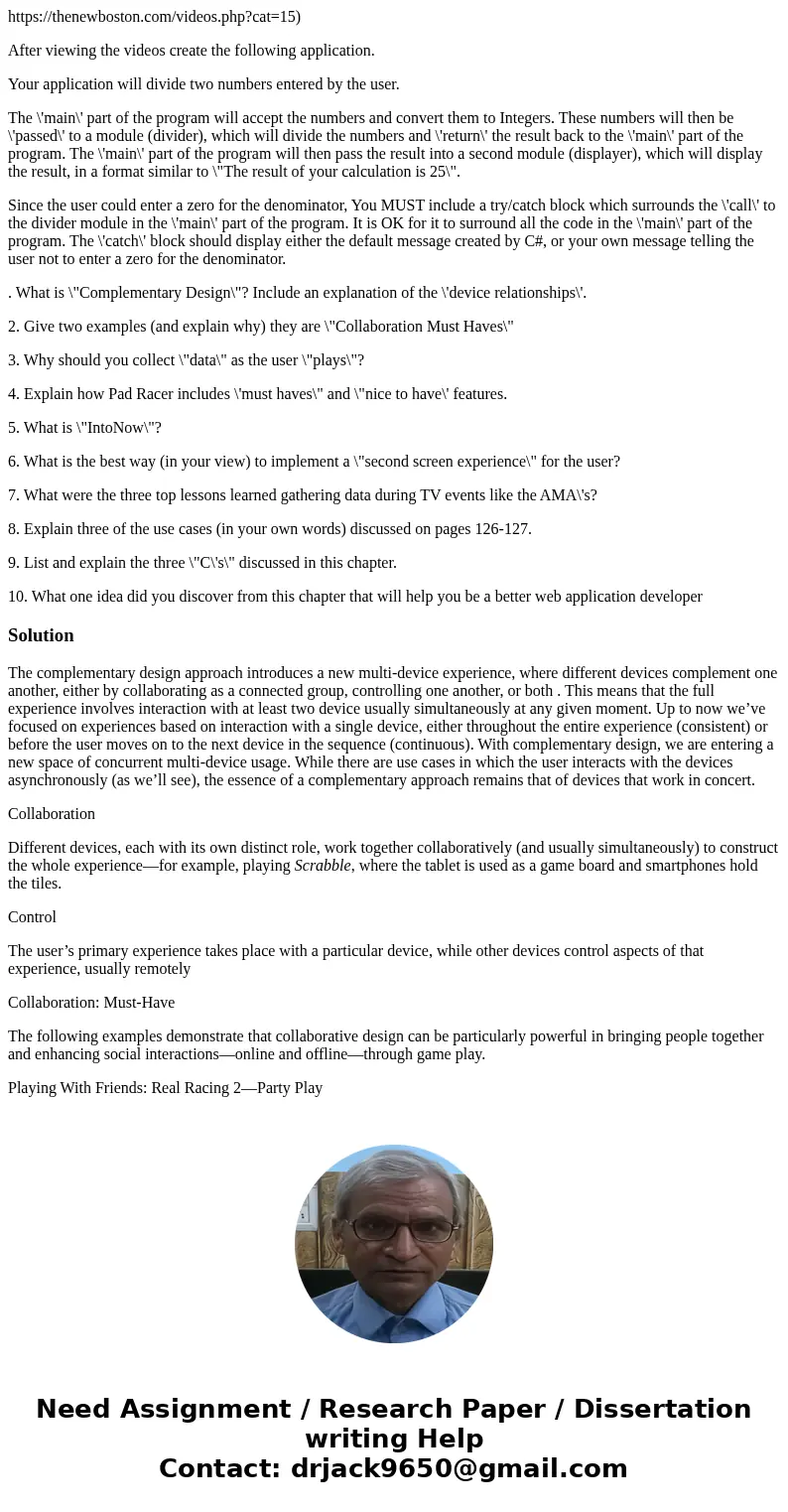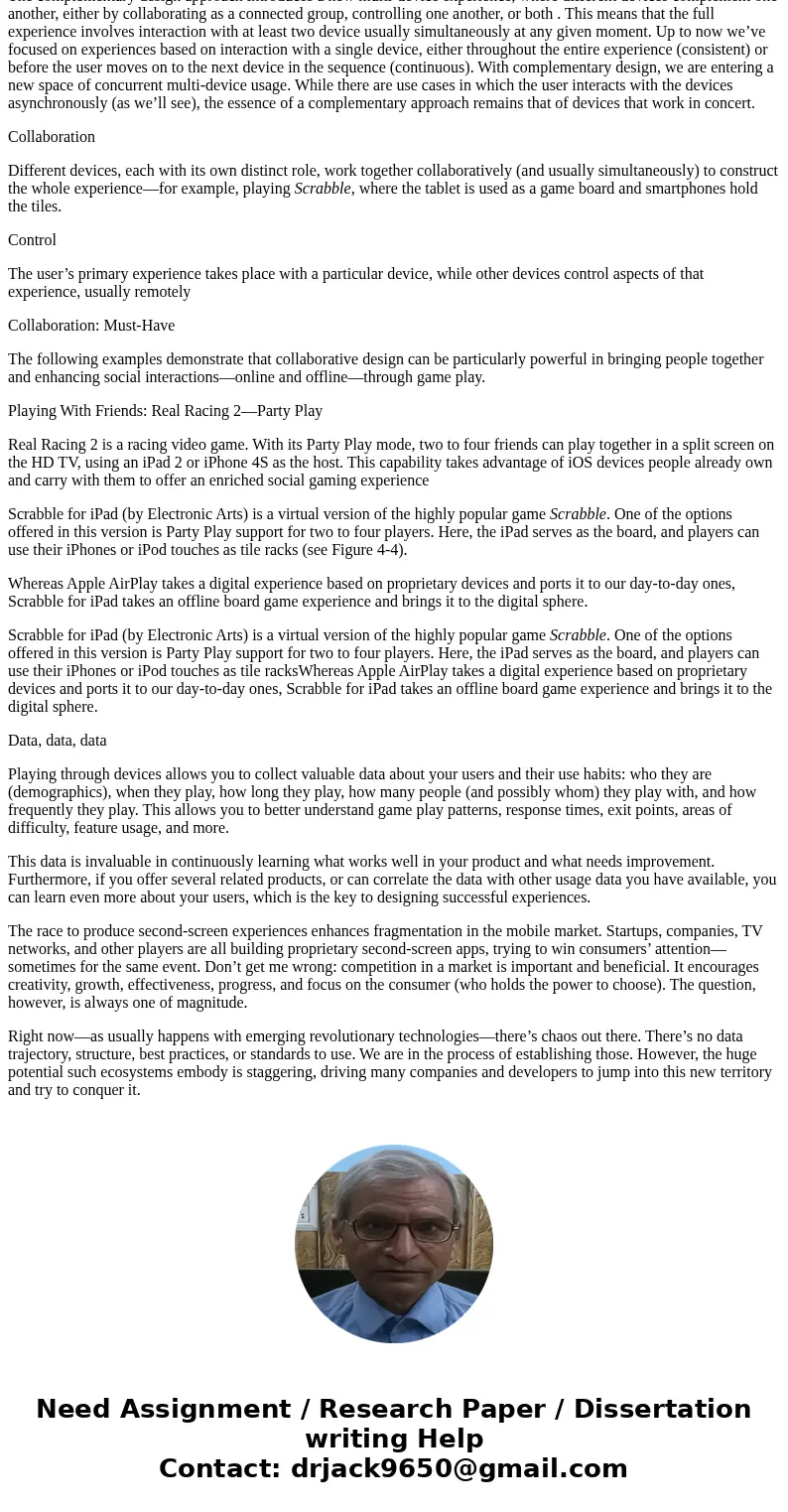httpsthenewbostoncomvideosphpcat15 After viewing the videos
https://thenewboston.com/videos.php?cat=15)
After viewing the videos create the following application.
Your application will divide two numbers entered by the user.
The \'main\' part of the program will accept the numbers and convert them to Integers. These numbers will then be \'passed\' to a module (divider), which will divide the numbers and \'return\' the result back to the \'main\' part of the program. The \'main\' part of the program will then pass the result into a second module (displayer), which will display the result, in a format similar to \"The result of your calculation is 25\".
Since the user could enter a zero for the denominator, You MUST include a try/catch block which surrounds the \'call\' to the divider module in the \'main\' part of the program. It is OK for it to surround all the code in the \'main\' part of the program. The \'catch\' block should display either the default message created by C#, or your own message telling the user not to enter a zero for the denominator.
. What is \"Complementary Design\"? Include an explanation of the \'device relationships\'.
2. Give two examples (and explain why) they are \"Collaboration Must Haves\"
3. Why should you collect \"data\" as the user \"plays\"?
4. Explain how Pad Racer includes \'must haves\" and \"nice to have\' features.
5. What is \"IntoNow\"?
6. What is the best way (in your view) to implement a \"second screen experience\" for the user?
7. What were the three top lessons learned gathering data during TV events like the AMA\'s?
8. Explain three of the use cases (in your own words) discussed on pages 126-127.
9. List and explain the three \"C\'s\" discussed in this chapter.
10. What one idea did you discover from this chapter that will help you be a better web application developer
Solution
The complementary design approach introduces a new multi-device experience, where different devices complement one another, either by collaborating as a connected group, controlling one another, or both . This means that the full experience involves interaction with at least two device usually simultaneously at any given moment. Up to now we’ve focused on experiences based on interaction with a single device, either throughout the entire experience (consistent) or before the user moves on to the next device in the sequence (continuous). With complementary design, we are entering a new space of concurrent multi-device usage. While there are use cases in which the user interacts with the devices asynchronously (as we’ll see), the essence of a complementary approach remains that of devices that work in concert.
Collaboration
Different devices, each with its own distinct role, work together collaboratively (and usually simultaneously) to construct the whole experience—for example, playing Scrabble, where the tablet is used as a game board and smartphones hold the tiles.
Control
The user’s primary experience takes place with a particular device, while other devices control aspects of that experience, usually remotely
Collaboration: Must-Have
The following examples demonstrate that collaborative design can be particularly powerful in bringing people together and enhancing social interactions—online and offline—through game play.
Playing With Friends: Real Racing 2—Party Play
Real Racing 2 is a racing video game. With its Party Play mode, two to four friends can play together in a split screen on the HD TV, using an iPad 2 or iPhone 4S as the host. This capability takes advantage of iOS devices people already own and carry with them to offer an enriched social gaming experience
Scrabble for iPad (by Electronic Arts) is a virtual version of the highly popular game Scrabble. One of the options offered in this version is Party Play support for two to four players. Here, the iPad serves as the board, and players can use their iPhones or iPod touches as tile racks (see Figure 4-4).
Whereas Apple AirPlay takes a digital experience based on proprietary devices and ports it to our day-to-day ones, Scrabble for iPad takes an offline board game experience and brings it to the digital sphere.
Scrabble for iPad (by Electronic Arts) is a virtual version of the highly popular game Scrabble. One of the options offered in this version is Party Play support for two to four players. Here, the iPad serves as the board, and players can use their iPhones or iPod touches as tile racksWhereas Apple AirPlay takes a digital experience based on proprietary devices and ports it to our day-to-day ones, Scrabble for iPad takes an offline board game experience and brings it to the digital sphere.
Data, data, data
Playing through devices allows you to collect valuable data about your users and their use habits: who they are (demographics), when they play, how long they play, how many people (and possibly whom) they play with, and how frequently they play. This allows you to better understand game play patterns, response times, exit points, areas of difficulty, feature usage, and more.
This data is invaluable in continuously learning what works well in your product and what needs improvement. Furthermore, if you offer several related products, or can correlate the data with other usage data you have available, you can learn even more about your users, which is the key to designing successful experiences.
The race to produce second-screen experiences enhances fragmentation in the mobile market. Startups, companies, TV networks, and other players are all building proprietary second-screen apps, trying to win consumers’ attention—sometimes for the same event. Don’t get me wrong: competition in a market is important and beneficial. It encourages creativity, growth, effectiveness, progress, and focus on the consumer (who holds the power to choose). The question, however, is always one of magnitude.
Right now—as usually happens with emerging revolutionary technologies—there’s chaos out there. There’s no data trajectory, structure, best practices, or standards to use. We are in the process of establishing those. However, the huge potential such ecosystems embody is staggering, driving many companies and developers to jump into this new territory and try to conquer it.


 Homework Sourse
Homework Sourse